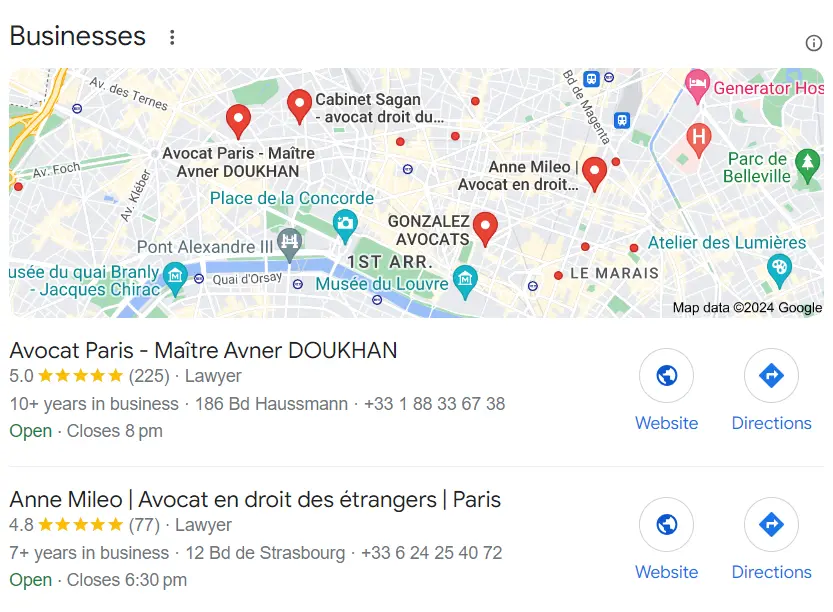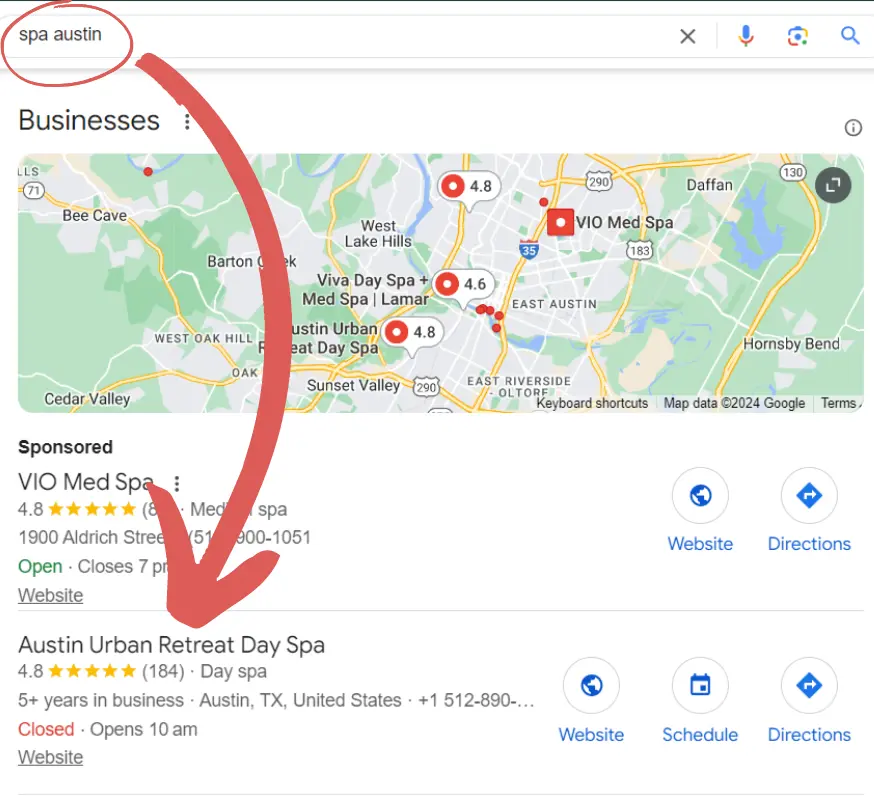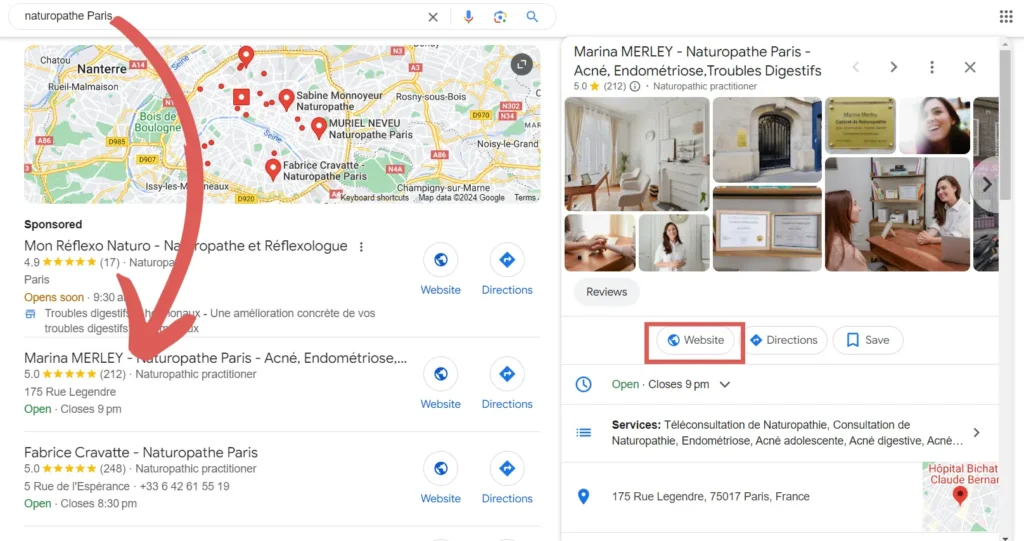Discover our local SEO ranking system which has allowed dozens of companies to generate new local customers.

I’m Marc-Antoine Thiriat, director at elevate. In this guide, I decided to share our local SEO system we perfected for years to bring visibility to our clients locally. This system helped numerous businesses generate local leads and customers.
You’ve probably heard about local SEO, the process of ranking your business in Google’s local pack for local queries like “lawyer in Paris.”
If you’re exploring local SEO, you may have found lots of “tips” but not much substance. You might also be frustrated if your competitors rank higher despite having fewer positive reviews…
In any case, you’re in the right place!
This guide explains a clear, step-by-step system for local SEO success, developed through trial and error at our SEO agency. It has helped many businesses attract qualified leads and boost revenue.
Pro tip: Save this guide for reference as it's packed with valuable information.
Local SEO (Search Engine Optimization) helps your business show up in local search results on search engines like Google. Local searches are those where users look for businesses nearby.
Examples of Local Searches:
If you’re unsure about starting local SEO, consider this statistic:
46% of Google searches are local (WebFX)
This means that by not including local SEO in your strategy, you are missing out on 46% of your addressable search market.
Google has created a special section for local searches called the “local pack,” which helps local businesses become more visible.
87% of consumers have searched for a local business on Google (BrightLocal 2023). This makes Google the best place for local businesses needing visibility.
If you’re still unsure that Google Local Pack is the right choice for your local business, consider this:
Google is the most trusted platform for consumers looking for reviews of local businesses across all industries (BrightLocal, 2023).

The goal of local SEO is to gain new customers. To achieve this, your audience goes through several stages. These stages form a sales funnel.
Search → Impression → Call or Visit to Website → Sale
A potential customer performs a local search on Google, such as “Spa in Austin.”. If your Google Business listing is well-optimized, it will appear at the top of the search results in the Local Pack.
42% of local searches lead to a click in the Local Pack (source).
If you are among the top results, your Google Business listing is likely to be visited. The user reads your description, reviews, and other details.
At this point, two things can happen:
Finally, the “sale” phase involves converting your leads into a customer. The call script depends on your product or service and should be well-prepared to guide your leads towards making a purchase.

You want to get your business listed in Google’s local pack, but for which keywords?
In other words, for which search terms do you want to appear on Google?
Not all keywords are equal. Some bring in qualified customers ready to buy, while others attract people just looking for information. You need to choose the right keywords to target, which can be challenging.
To select the right keywords, consider these three criteria:
Ideally, you want to choose relevant keywords with high search volume, and low competition.
Tools like Ahrefs can help you find keywords and analyze these three criteria.
The goal is not to aim for the top spot in Google’s local pack for all your keywords (which is impossible anyway).
The goal is to accumulate impressions (appearances of your Google Business listing) for a wide range of different keywords:
It’s the combined impressions from these various keywords that will build your online visibility, bringing clicks to your website and calls to your phone.
Now, I’m going to share with you the system we use to get our clients listed in Google’s Local Pack.
To my knowledge, there’s nothing else quite like this guide. This system will be invaluable to you, as long as you follow it diligently. Let’s get started!
We have created the ultimate checklist for launching your Google Business Profile. This is the foundation of your local SEO. If this part isn’t done correctly, your chances of ranking for local searches will be compromised.
If you already have a Google Business Profile (GMB), you can use this checklist to audit your account.
This pre-launch step involves listing the keywords you will target in your local SEO campaign. Without this step, you won’t know where you’re heading, so it’s essential.
Here’s how to find the right keywords:
Search for a keyword you want to rank for on Google. For example, let’s use “Naturopath in Paris.”


Competitor Analysis: Identify the competitor ranked first in Google’s Local Pack. Copy their website URL and analyze it using a tool like Ahrefs.
Ahrefs will show you all the keywords your competitor is already ranking for. Extract this list and filter for relevant local keywords.
For example, you might find:
Add all these keywords to your list.
Our list of keywords is ready, now let’s create our profile.
Go to Google Business and follow the setup steps.
Follow the steps carefully and fill in these fields:
| Fields | Description |
| Business name | |
| Categories |
Choose your categories and subcategories wisely. Be broad but stay relevant. |
| Business description | |
| Link to your website |
For a single-location business, link to your homepage or a page that includes the main keyword. For multi-location businesses, link your Google Business profile to the local page of your website. |
|
Add Your Services/Products |
|
| Publish an update | Google Business allows you to publish updates. Share news, events, or inrtoduce your services and team. This helps keep your profile active. |
| Add photos and videos of your business |
Show users what their experience with your business and team will be like |
| Link your social media channels |
Facebook, LinkedIn, Instagram: These help make your business more credible to Google |
In this step, you will create an online profile for your business in various directories. This helps Google recognize your business and improves your local search ranking.
Choose a few relevant directories for your business and set up your profile there.
There are two types of relevant directories:
Large general directories include all kinds of businesses and are significant due to their size. For example, Yellow Pages.
Industry-specific directories only list certain types of businesses. For instance, Tripadvisor is a relevant directory for a restaurant.
Have you already listed your business in directories?
Ensure that the following information is consistent across all your profiles:
This step is often the most challenging for businesses: getting reviews!
Positive reviews are crucial for boosting your local search rankings.
Many businesses feel unprepared to consistently receive positive feedback, often getting only occasional good reviews.
Positive reviews are the key difference between a well-ranked, customer-attracting business and others.
There’s no secret formula for this. The best way to get positive reviews is simply to ask for them.
Encourage your customers to leave a genuine review on your Google Business profile. Additionally, consider working with a link building agency to improve your online authority, as both reviews and backlinks can significantly enhance your local SEO ranking.
You’ve set up your Google Business profile and started attracting new customers. Now, it’s important to maintain your presence on Google by updating your profile monthly.
Follow these steps at least once a month:
Replying to positive reviews keeps your profile active and helps build a connection with your customers. Also, give a “Like” to positive reviews.
Do not reply to negative reviews: It might seem strange, but don’t respond to negative reviews.
If you can identify the customer, reach out to them and try to resolve the issue. Then, ask them to remove their review. If this doesn’t work, report the negative review to Google (directly from the review).
If that still doesn’t work, contact Google directly and request the removal of the negative review, explaining that it is unfair since you did everything possible to fix the problem.
Do you have an event to share? Talk about it in a post. This will keep your profile active while sharing your event with the relevant people.
You are now maintaining your local SEO for multiple keywords. It’s time to optimize your strategy.
First, you need to measure your performance.
Traditional SEO agencies talk about impressions, call numbers, and website visits. But they often can’t measure the impact on your revenue. Getting visitors is good, but it’s not the main goal.
The ultimate performance indicator for your local SEO strategy is your revenue. The question is, “How much does local SEO earn me?”
To measure this, we’ve developed a tool called leadsources.io. It links each sale to its source (Facebook, Google, Instagram, etc.).
This way, you can measure the impact of your SEO campaign on your revenue and compare these results with other advertising campaigns.

You’ve put effort into building your local SEO, and you’ve noticed it has a bigger impact on your revenue than the Facebook ads that cost you €500 a month.
Consider shifting your Facebook ad budget to your local SEO to boost your local search rankings. Our agency can conduct an audit of your Google Business profile and implement improvements that will enhance your SEO.
Local SEO is no longer a mystery to you.
If you like our content but don’t have the time to manage your SEO, our agency can handle it for you.
The difference between a business that boosts its revenue through local SEO and one that doesn’t is the ability to execute our system effectively.
Whether you do it on your own or with an agency, there’s no reason not to dive into local SEO 🙂
Good luck!